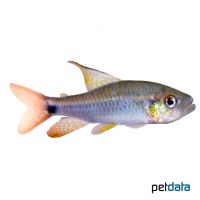Sailfin Tetra (Crenuchus spilurus)
| Sailfin Tetra Crenuchus spilurus | |
|---|---|
| Name | Sailfin Tetra |
| Name Lat. | Crenuchus spilurus |
| Family | South American Darters |
| Family lat. | Crenuchidae |
| Order | Characins |
| Order lat. | Characiformes |
| Origin | South America |
| Habitat | Forest streams |
| Diet | Carnivore |
| pH | 4.0-6.5 |
| Behavior | ♂ territorial |
| Keeping | Pair, harem |
| Care Level | Experts only |
| Reproduction | Cave spawner |
| Breeding | Difficult |
| Life Span | 3-5 years |
| Protection | No |
| Metric Units | |
| Size | ♀ 4 cm, ♂ 6 cm |
| Temperature | 24-28 °C |
| Hardness | 1-5 °dH |
| Aquarium | ~ 70 l |
| US Units | |
| Size | ♀ 1.5", ♂ 2.3" |
| Temperature | 75-82 °F |
| Hardness | 0-89 ppm |
| Aquarium | ~ 20 gal |
Distribution and habitat
Small predatory tetras are common in coastal rivers of Guyana, tributaries of the Orinoco River, and the upper and middle Amazon. There they live in the blackwater of stagnant tributaries in densely forested areas with dense underwater and riparian vegetation
Maintenance
The aquarium should have a varied, partly dense planting, with shelters and hiding places (roots, bamboo tubes) and provide sufficient swimming space. Soft, slightly acidic water, a dark substrate covered with some foliage (e.g. sea almond leaves) and shaded light (floating plants) is ideal
No ammonia, ammonium and nitrite should be detectable in the water, and the nitrate value should not exceed 100 mg/l. To ensure water quality and oxygen content, a filter and heater adapted to the size of the aquarium is required, as well as lighting for the species-appropriate day-night rhythm of the animals.
Diet
They are ambush hunters that feed mainly on small insects and larvae in the wild. The food supply consists of live and frozen food. Feed once daily with cyclops, daphnia, bosmids, artemia or mosquito larvae (live or frozen). Protein-rich, sinking dry food is rarely accepted and should not be a main component of the diet
It is recommended to feed small portions several times a day, which are eaten within a few minutes. A regular and varied diet promotes health and increases resistance.
Behaviour and compatibility
The shy and not very swim-friendly fish should be kept as a pair or in a harem, a male with several females. The males form small territories without showing aggression towards other fish. Several males should only be kept together in a larger and richly structured tank. A socialization with other tetra species of the same size is well possible. In principle, only mutually compatible fish species with similar requirements to the water condition and water temperature may be socialized.
Sex dimorphism
Males are larger and more colorful than females and have an elongated dorsal fin.
Reproduction and breeding
The female lays up to 100 eggs on the ceiling of a cave and the male performs the brood care. After about 8 days the fry swim free and the brood care ends. The fry must be fed several times a day with special rearing food (infusoria, Artemia nauplii)
In a community tank breeding is hardly possible, because the fry are easy prey.
Important
In their range there are differently colored populations. They are slow feeders and have high demands on water quality.
The foliage (sea almond tree, oak, etc.) enriches the water with humic substances and naturally lowers the pH.
The well-being of the fish should be checked regularly. The temperature should be checked daily, the pH, hardness and nitrate value at least every 14 days. Regular partial water changes are recommended, even if the contaminant level has not yet reached the upper limit. Sudden changes in water quality should be avoided. Newly introduced fish must be accustomed slowly to the water in the aquarium.
Further literature can be found in your pet store
References
Text: petdata; Image: petdata
Source: BMELV (1998): Tierschutzgutachten - Haltung von Zierfischen (Süßwasser); RIEHL & BAENSCH (2006): Aquarien Atlas Bd. 1, Mergus Verlag; ENGELMANN (2005): Zootierhaltung - Tiere in menschlicher Obhut: Fische, Verlag Harri Deutsch
- Gemäß § 21 Abs. 5 Tierschutzgesetz idgF
